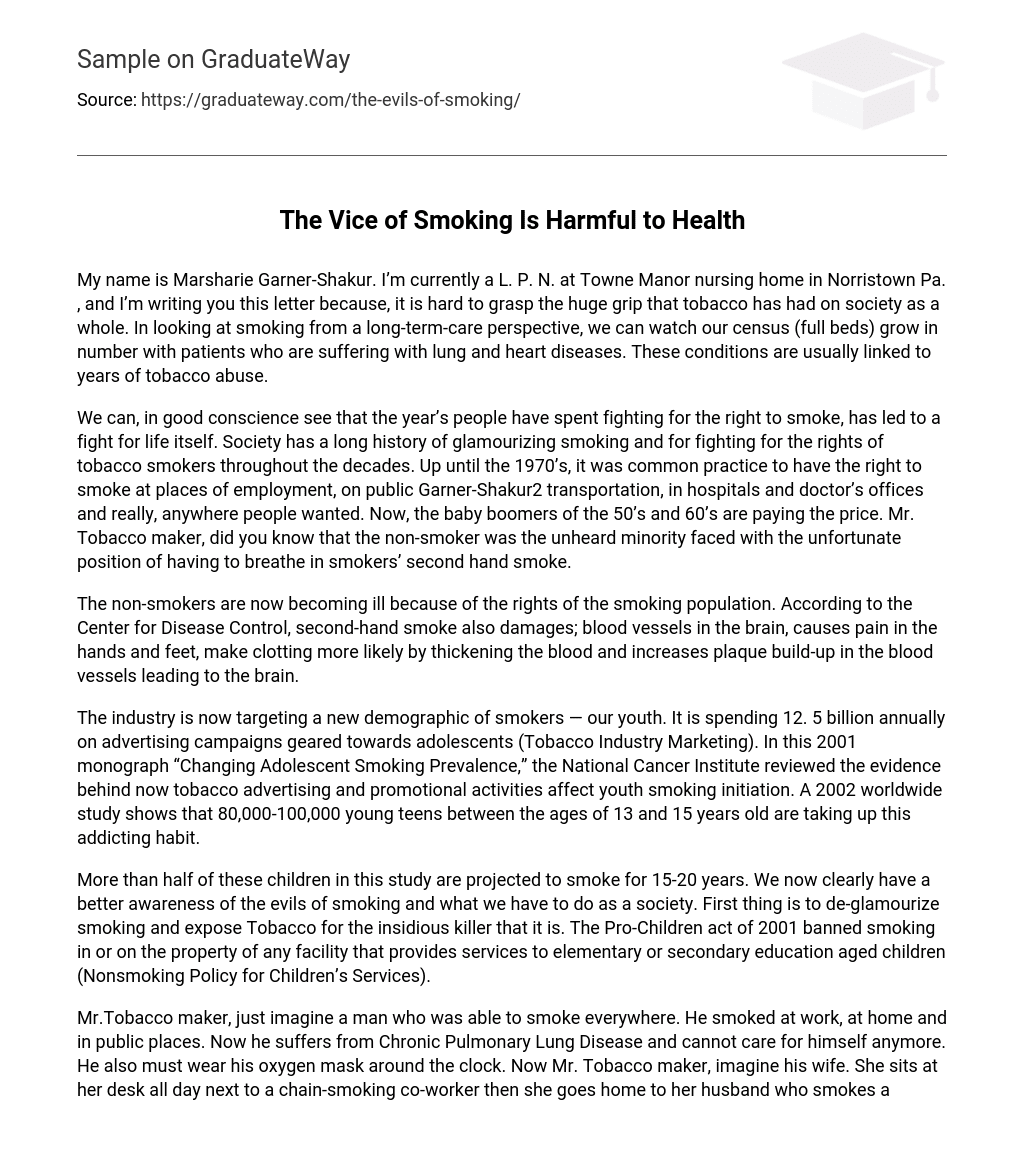My name is Marsharie Garner-Shakur. I’m currently a L. P. N. at Towne Manor nursing home in Norristown Pa. , and I’m writing you this letter because, it is hard to grasp the huge grip that tobacco has had on society as a whole. In looking at smoking from a long-term-care perspective, we can watch our census (full beds) grow in number with patients who are suffering with lung and heart diseases. These conditions are usually linked to years of tobacco abuse.
We can, in good conscience see that the year’s people have spent fighting for the right to smoke, has led to a fight for life itself. Society has a long history of glamourizing smoking and for fighting for the rights of tobacco smokers throughout the decades. Up until the 1970’s, it was common practice to have the right to smoke at places of employment, on public Garner-Shakur2 transportation, in hospitals and doctor’s offices and really, anywhere people wanted. Now, the baby boomers of the 50’s and 60’s are paying the price. Mr. Tobacco maker, did you know that the non-smoker was the unheard minority faced with the unfortunate position of having to breathe in smokers’ second hand smoke.
The non-smokers are now becoming ill because of the rights of the smoking population. According to the Center for Disease Control, second-hand smoke also damages; blood vessels in the brain, causes pain in the hands and feet, make clotting more likely by thickening the blood and increases plaque build-up in the blood vessels leading to the brain.
The industry is now targeting a new demographic of smokers — our youth. It is spending 12. 5 billion annually on advertising campaigns geared towards adolescents (Tobacco Industry Marketing). In this 2001 monograph “Changing Adolescent Smoking Prevalence,” the National Cancer Institute reviewed the evidence behind now tobacco advertising and promotional activities affect youth smoking initiation. A 2002 worldwide study shows that 80,000-100,000 young teens between the ages of 13 and 15 years old are taking up this addicting habit.
More than half of these children in this study are projected to smoke for 15-20 years. We now clearly have a better awareness of the evils of smoking and what we have to do as a society. First thing is to de-glamourize smoking and expose Tobacco for the insidious killer that it is. The Pro-Children act of 2001 banned smoking in or on the property of any facility that provides services to elementary or secondary education aged children (Nonsmoking Policy for Children’s Services).
Mr.Tobacco maker, just imagine a man who was able to smoke everywhere. He smoked at work, at home and in public places. Now he suffers from Chronic Pulmonary Lung Disease and cannot care for himself anymore. He also must wear his oxygen mask around the clock. Now Mr. Tobacco maker, imagine his wife. She sits at her desk all day next to a chain-smoking co-worker then she goes home to her husband who smokes all night. She subsequently has Lung Cancer and is on Hospice. This is a woman who never smoked a day in her life. In conclusion, our fight is paying off.
Today, in 2013, non-smokers are currently winning the right to breathe clean air in restaurants, casinos, schools, Garner-Shakur 4 and public transportation. These may seem like small victories in comparison to the countless causalities of tobacco to you Mr. Tobacco maker, but our fight is not over. We will continue to make this our responsibility and will continue to educate our younger members of society about the evils of smoking. Our children need to know they have the right to choose life, for themselves and future generations.





